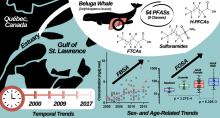| Title | Current and historical concentrations of poly and perfluorinated compounds in sediments of the northern Great Lakes - Superior, Huron, and Michigan. |
| Publication Type | Journal Article |
| Year of Publication | 2018 |
| Authors | Codling, G, Hosseini, S, Corcoran, MB, Bonina, S, Lin, T, Li, A, Sturchio, NC, Rockne, KJ, Ji, K, Peng, H, Giesy, JP |
| Journal | Environ Pollut |
| Volume | 236 |
| Pagination | 373-381 |
| Date Published | 2018 May |
| ISSN | 1873-6424 |
| Keywords | Environmental Monitoring, Fluorocarbons, Geologic Sediments, Great Lakes Region, Lakes, Water Pollutants, Chemical |
| Abstract | Current and historical concentrations of 22 poly- and perfluorinated compounds (PFASs) in sediment collected from Lake Superior and northern Lake Michigan in 2011 and Lake Huron in 2012 are reported. The sampling was performed in two ways, Ponar grabs of surface sediments for current spatial distribution across the lake and dated cores for multi-decadal temporal trends. Mean concentrations of the sum of PFASs (∑PFASs) were 1.5, 4.6 and 3.1 ng g dry mas (dm) in surface sediments for Lakes Superior, Michigan and Huron, respectively. Of the five Laurentian Lakes, the watersheds of Superior and Huron are the less densely populated by humans, and concentrations observed were typically less and from more diffuse sources, due to lesser urbanization and industrialization. However, some regions of greater concentrations were observed and might indicate more local, point sources. In core samples concentrations ranged from 7 that include perfluoro-n-octane sulfonate (PFOS) bind more strongly to sediment, which resulted in more accurate analyses of temporal trends. Shorter-chain PFASs, such as perfluoro-n-butanoic acid which is the primary replacement for C8 PFASs that have been phased out, are more soluble and were identified in some core layers at depths corresponding to pre-production periods. Thus, analyses of temporal trends of these more soluble compounds in cores of sediments were less accurate. Total elemental fluorine (TF) and extractable organic fluorine (EOF) indicated that identified PFASs were not a significant fraction of fluorine containing compounds in sediment (<0.01% in EOF). |
| DOI | 10.1016/j.envpol.2018.01.065 |
| Alternate Journal | Environ. Pollut. |
| PubMed ID | 29414360 |
Environmental Chemical Biology

